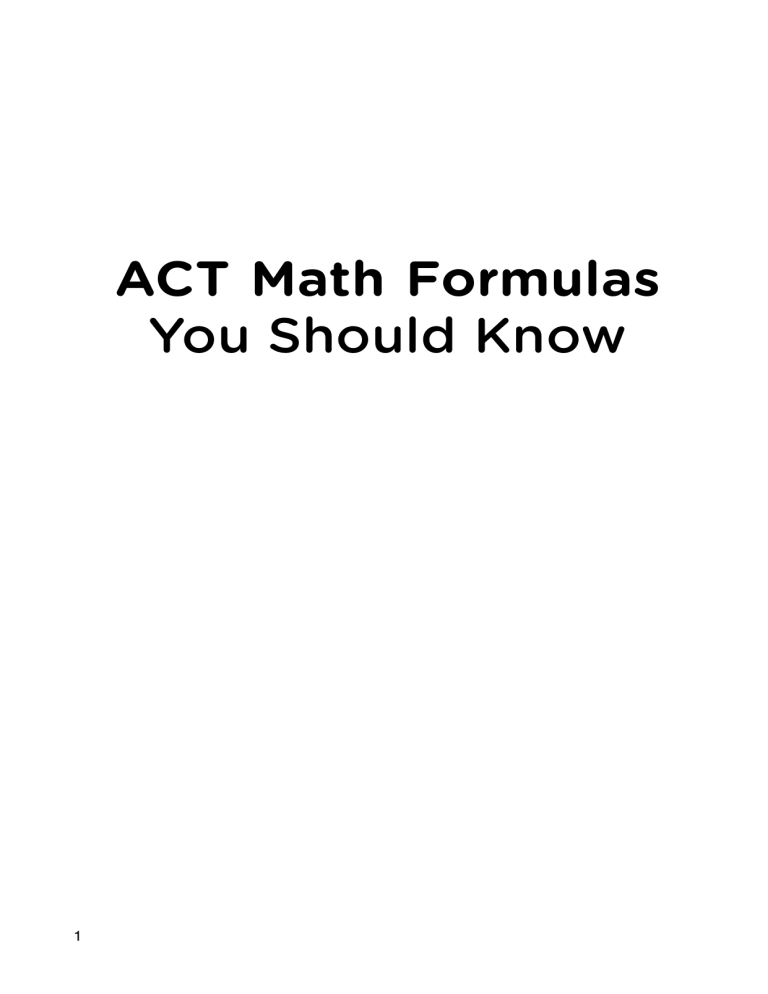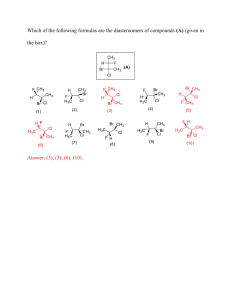
ACT Math Formulas You Should Know 1 About The ACT Math The ACT Math tests students on high school math that should be learned between grades 9-11. Unlike the SAT, the ACT Math section does not provide a list of formulas that can be used on the test. Understanding and memorizing the majority of these formulas we’ve provided in this PDF are vital for success. Print this out for easy studying! ACT Math Details - 60 multiple choice questions - 60 minutes - Calculator usage is permissible Content Breakdown Pre-Algebra (20-25%) decimals, fractions, integers, place value, square roots, exponents, scientific notation, factors, ratios, proportions, percents, linear equations, statistical charts and graphs Elementary Algebra (15-20%) exponents, square roots, algebraic expressions through substitution, using variables to express functional relationships, algebraic operations, quadratic equations by factoring Intermediate Algebra (15-20%) quadratic formula, rational and radical expressions, absolute value equations and inequalities, sequences and patterns, functions and modeling, matrices, roots and polynomials, complex numbers, systems of equations, quadratic inequalities 2 Coordinate Geometry (15-20%) distance, midpoints, conics, evaluating points and lines on a graph, graphing inequalities, parallel and perpendicular lines Plane Geometry (20-25%) properties of circles, triangles, rectangles, parallelograms, and trapezoids, properties and relations of plane figures angles and parallel lines, transformations, volume, area, three-dimensional geometry Trigonometry (5-10%) trig relations in right triangles, values and properties of trig functions, graphing, using identities, and solving trig equations 3 10 Must-Know ACT Math Formulas Set up a percentage fraction This is more of a key concept because it can be applied to a variety of questions. Just rearrange the formula to solve for whatever "x" is. Standard linear equation y = mx + b. Where m is the slope and b is the y intercept. This formula will certainly be on the test. It may not always be written in this standard form, so just be sure that you understand how to rearrange the equation to make it look like this. Slope aka This formula is so important we have an entire article dedicated to it! You are going to see this on the test and likely in a variety of ways. 4 Perimeter of rectangle P= 2l + 2w Area of rectangle A=l×w Volume of cuboid V=l×w×h Circumference of circle C = 2πr Area of circle Pythagorean theorem This is one of the most, most, most important formulas to know! It's sure to make any appearance on the test, and knowing this will allow you to solve a variety of questions (see distance of a line segment above). SOHCAHTOA 5 9 Good-to-Know ACT Math Formulas Mean (average) These questions will appear on the test, and this is a relatively easy formula to memorize. Probability Try to think in terms of percent fraction to help you remember this one. Factorials ! = multiply number by each smaller whole number down to one. Sometimes (but not always!) they remind you in the question what a factorial is. 6 Mid point You will probably see a question dealing with the midpoint of a line. This is listed under "good to know" rather than "need to know" because if you think about it, you are basically taking the average of the x and y coordinates, so thinking about this intuitively might be better than pure memorization. Length of a line segment This is good to know, but if you are crunched for time studying you can skip memorizing this and simply graph the coordinates; set up a right triangle and solve for the hypotenuse to get the answer. The downside with this method, however, is that it will take longer to answer this type of question come test time! Area of a triangle Surface area of cuboid TSA = 2(lw + wh + hl) 7 Volume of a sphere Special triangles - 3/4/5 A triangle with sides of 3, 4, and 5 will always be a right triangle, even if the problem does not explicitly state it. - 45o/45o/90o In these triangles, the ratio of sides will with always be corresponding to the hypotenuse. - 30o/60o/90o In these triangles, the ratio of sides will , with "2" corresponding to the hypotenuse. always be * Knowing these shortcuts will help you save time on the test! 8 Some Other Formulas to Keep in Mind Geometric and arithmetic sequences Arithmetic: an = a1 + d(n-1). Where an is the nth term of the series, a1 is the first number of the series, and d is the difference between the numbers. Geometric: an = a1 × rn-1. Where an is the nth term of the series, a1 is the first term in the series, and r is the factor that you multiply by in order to progress from one term to the next. If you are aiming to get every point possible, more difficult series questions will appear toward the end of the test that would benefit from these formulas. Permutations and combinations Permutations: Combinations: Again, like the series formulas, questions requiring these formulas will only account for a point or two on the test. 9 Quadratic equation This is of lower priority than other formulas because most of the time you can factor the quadratic. However, if a question asks about imaginary numbers with quadratics, then knowing this equation is essential to solving the problem. Equation of a circle (x - h)2 + (y - k)2 = r2. Where (h, k) are the center coordinates of the circle. Usually there is only one question on the test that requires this formula. Area of a trapezoid/parallelogram A trick here is to make triangles and solve the "pieces" of the trapezoid. Volumes cones and cylinders Cone: Cylinder: 10 Length of chord Area of sector Law of cos and sine If you see a trigonometry question that can't be answered knowing SOHCAHTOA, then you will probably need to know these formulas, but they don't come up often. 11 12
